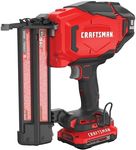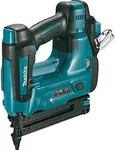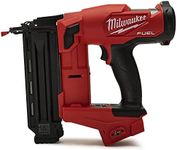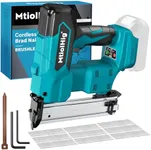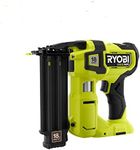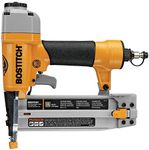Buying Guide for the Best 18 Gauge Brad Nailers
Choosing the right 18-gauge brad nailer can make your woodworking or home improvement projects much easier and more precise. These tools are designed for delicate trim work, cabinetry, and other tasks where you want a strong hold without splitting the wood or leaving large holes. To find the best fit for your needs, it's important to understand the key features and how they relate to the type of work you plan to do.Power SourceThe power source refers to how the brad nailer is powered—either by air (pneumatic), battery (cordless), or sometimes electric cord. Pneumatic nailers use an air compressor and are known for being lightweight and reliable for long sessions, but they require you to have and manage a compressor and hose. Cordless models use rechargeable batteries, offering more mobility and convenience, especially for quick jobs or work in tight spaces, but they can be heavier and may need recharging. Electric corded models are less common but provide continuous power without the need for a compressor or battery. Your choice should depend on whether you value portability and convenience or plan to work in a fixed location for longer periods.
Nail Length CapacityNail length capacity tells you the range of brad nail sizes the tool can handle, usually from about 5/8 inch to 2 inches. Shorter nails are ideal for thin trim and delicate work, while longer nails are better for thicker materials or when you need a stronger hold. If you plan to do a variety of projects, look for a nailer with a wide range of nail length compatibility. If your work is more specialized, you can focus on a model that fits your most common nail size.
Magazine CapacityMagazine capacity is the number of nails the tool can hold at once. A higher capacity means you can work longer without stopping to reload, which is helpful for larger projects. Lower capacity models are lighter and may be easier to handle for small, precise jobs. Think about how often you want to reload and the size of your typical project when considering this feature.
Depth AdjustmentDepth adjustment allows you to control how deep the nail is driven into the material. This is important for getting a clean finish and avoiding damage to your workpiece. Some nailers have tool-free depth adjustment, making it easy to change settings on the fly, while others require a tool. If you work with different materials or want more control over your finish, look for easy and precise depth adjustment.
Jam Clearing MechanismA jam clearing mechanism helps you quickly remove nails that get stuck in the tool. Jams can happen, especially with lower quality nails or when working quickly. Some nailers have tool-free jam release, which lets you clear jams without extra tools, saving time and frustration. If you value smooth workflow and minimal interruptions, this is a feature to prioritize.
Weight and ErgonomicsWeight and ergonomics refer to how heavy the tool is and how comfortable it is to hold and use. Lighter nailers are easier to maneuver, especially for overhead or extended use, while heavier models may cause fatigue. Ergonomic grips and balanced designs make the tool more comfortable and reduce strain. Consider how long you’ll be using the nailer at a time and whether you need to work in awkward positions.
Exhaust DirectionExhaust direction is about where the tool directs the air it expels after firing a nail. Adjustable exhaust lets you point the air away from your face or work area, which can make your work more comfortable and keep dust from blowing into your eyes. If you often work in dusty environments or care about comfort, look for a model with adjustable exhaust.




